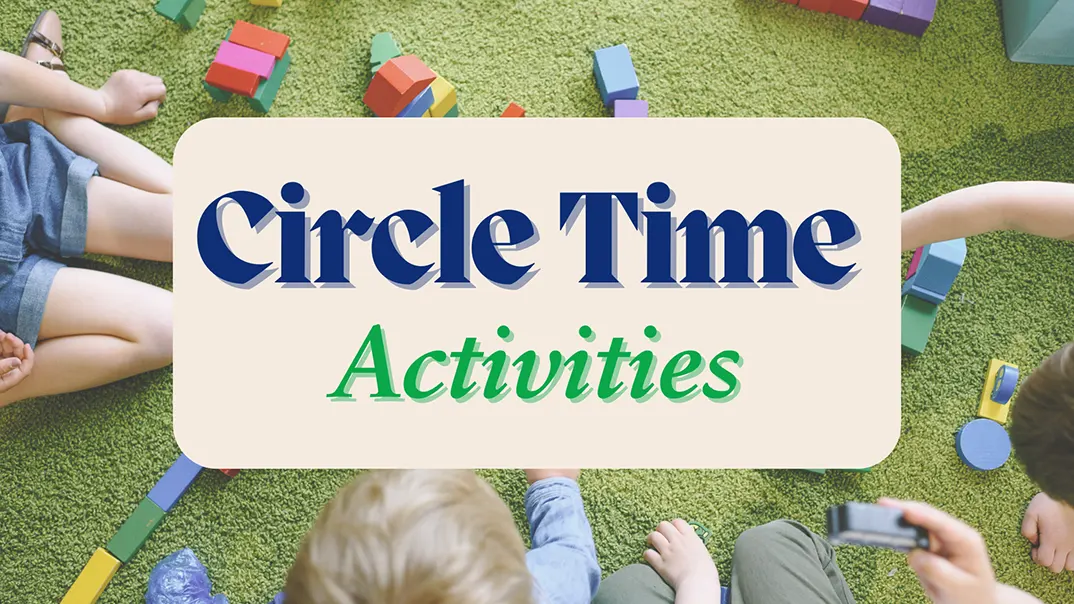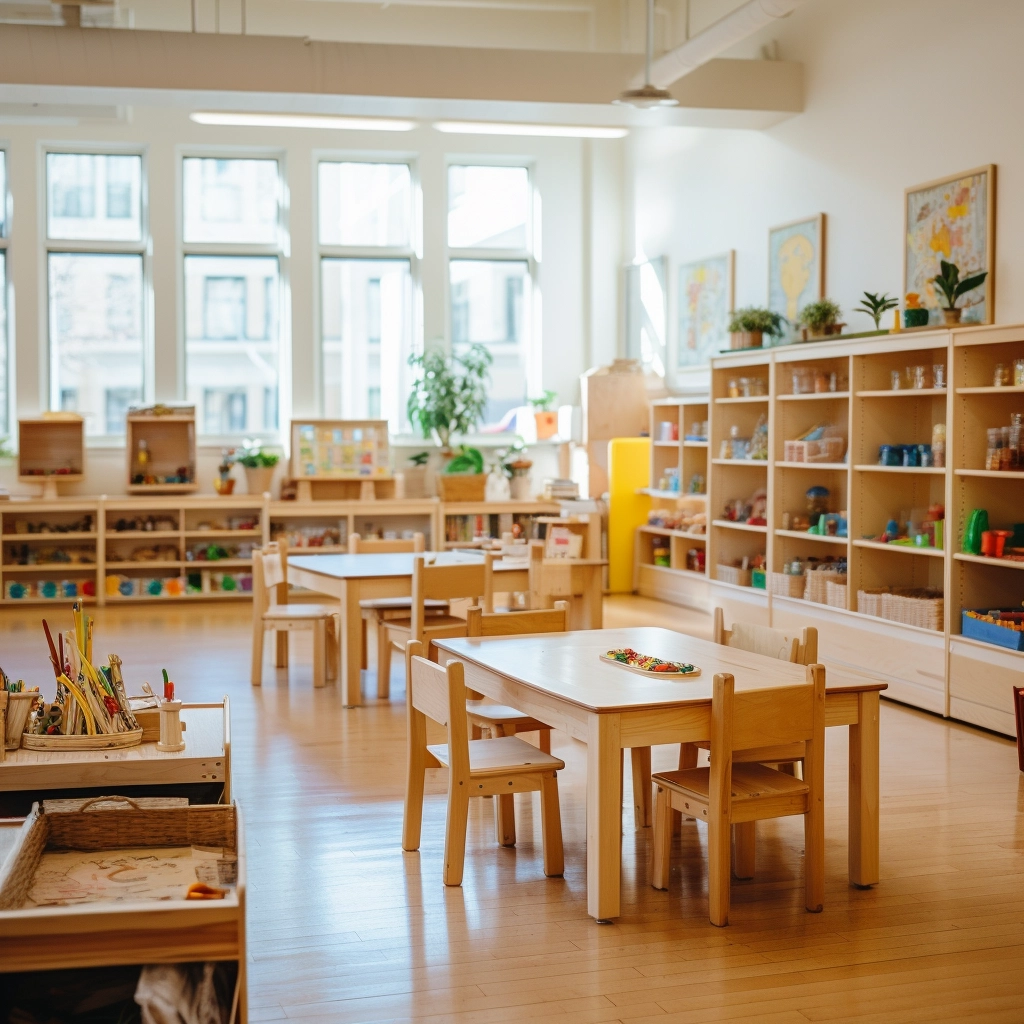Circle time is a vital part of the preschool day. It creates a structured environment where young children build foundational skills through shared songs, stories, movement, and conversation. When used consistently, it supports language development, emotional regulation, and social understanding.
For educators, planning effective circle time activities requires more than gathering children in a circle. It involves selecting developmentally appropriate experiences that engage attention, promote communication, and reinforce classroom routines.
This guide provides over 30 carefully curated circle time activities designed for preschool classrooms. These activities support whole-child development and align with early learning standards across key domains.
What Are Circle Time Activities?
Circle time activities are structured group experiences that take place in early childhood classrooms, typically at the start or end of the school day. During this time, children gather together in a circle either on the floor or in a designated carpet area and participate in shared routines that include songs, greetings, stories, discussions, movement, and calendar review. The purpose of circle time is to build a sense of community, establish classroom expectations, and support the development of early learning skills.
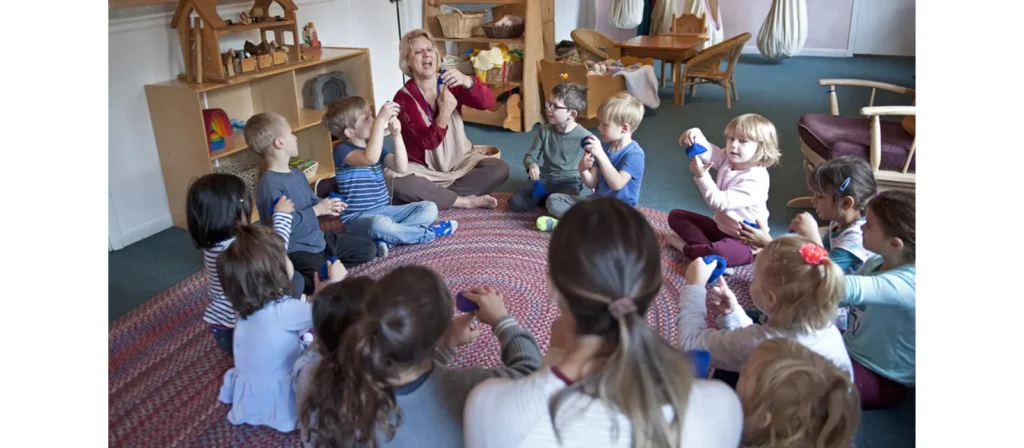
Effective circle time activities are intentional, consistent, and developmentally appropriate. While the format may vary across classrooms and age groups, successful routines share several key traits: they are interactive, inclusive, and rhythmically familiar. When used well, circle time activities become a predictable anchor in the daily schedule, giving children the comfort of routine and the joy of participation.
Typical components include:
- Warm-up signal and greeting
- Song or chant with actions
- Picture or object prompt for talk time
- Quick skill game for early literacy or math
- One-minute movement reset
- Closing routine that points to the next part of the day
Key Benefits of Circle Time Activities
Circle time activities are more than just a cheerful way to start the day. They provide a wide range of developmental, emotional, and social benefits for preschool-aged children. By incorporating meaningful interactions into a predictable daily routine, educators can use circle time to nurture essential skills that children will carry with them far beyond the classroom.
- Supports Sviluppo socio-emotivo
Circle time provides children with regular opportunities to build meaningful connections with their peers and teachers. Through greetings, songs, and group discussions, children learn how to recognize emotions, express their thoughts, and respectfully respond to others. These interactions help develop empathy, self-awareness, and emotional regulation, all of which are essential for forming healthy relationships. - Improves Language and Communication Skills
During circle time, children are exposed to a rich variety of language through songs, stories, and conversation. These experiences support vocabulary development, sentence formation, and listening comprehension. Children also practice turn-taking, eye contact, and active listening, which are important elements of effective communication in both academic and social settings. - Promotes a Sense of Routine and Belonging
When children participate in consistent group activities each day, they develop a clear understanding of classroom expectations and daily structure. This sense of routine helps them feel safe and confident. Sitting together in a circle reinforces the idea that every child is an equal and valued member of the classroom community, promoting inclusion and mutual respect. - Encourages Cooperative Behavior
Circle time activities often require collaboration, such as singing together, passing an object, or participating in partner games. These activities teach children how to share attention, wait their turn, and contribute to a group effort. Over time, this builds important social skills like cooperation, patience, and teamwork. - Enhances Cognitive and Academic Readiness
Many circle time routines incorporate early academic concepts such as counting, letter recognition, and calendar review. These experiences introduce foundational math and literacy skills playfully and memorably. Activities that involve patterns, rhymes, or repetition also strengthen memory and cognitive flexibility. - Sviluppa le capacità motorie fini e grossolane
Circle time often includes physical movement, such as fingerplays, clapping games, or simple exercises. These activities support the development of fine motor coordination and body awareness. Movement also helps children release excess energy and improve their ability to focus during more structured parts of the day. - Builds Listening and Attention Span
Regular participation in circle time helps children practice sustained attention and self-control. As they learn to listen to a story, follow directions in a song, or respond to a teacher’s prompt, they strengthen their ability to stay engaged in a group setting. These skills are crucial for future classroom success.
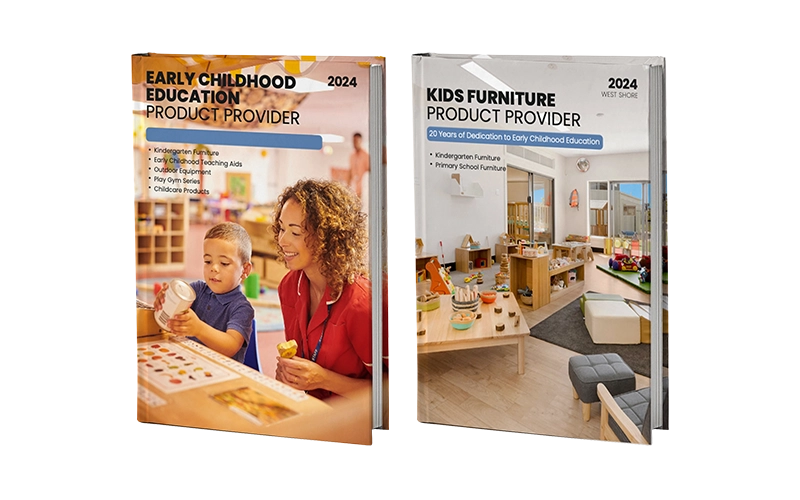
Meaningful Topics to Discuss During Circle Time
Choosing the right topics can turn a simple gathering into a powerful moment for learning, connection, and emotional growth. The key is to focus on ideas that are relevant to children’s lives, easy to understand, and open-ended enough to encourage participation.
Feelings and Emotions
Talking about emotions helps children learn how to identify, name, and manage their feelings. Teachers can invite children to share how they are feeling today and why. Using visuals such as feeling cards or emotion charts can support children who are still developing language skills. These discussions promote emotional awareness, empathy, and the ability to recognize feelings in others.
Meteo e stagioni
Discussing the weather is a classic circle time topic that builds observation skills and introduces scientific vocabulary. Children can take turns describing what they see outside, naming the season, and talking about how the weather affects what they wear or do. Over time, this daily habit builds a strong foundation for understanding changes in the natural world.
Days of the Week and Calendar Events
Reviewing the day of the week, the month, and upcoming classroom events helps children understand time concepts and daily structure. Teachers can also connect the calendar to classroom routines or special occasions such as birthdays, holidays, or field trips. These discussions reinforce sequencing, anticipation, and group awareness.
Classroom Rules and Routines
Circle time is a good moment to revisit classroom expectations and problem-solve any challenges that may have come up. Asking children what rules help the class stay safe or how to solve common issues promotes self-regulation and community responsibility. These conversations are also a gentle reminder of shared values and respectful behavior.
Themes and Topics of the Week
If your classroom follows weekly or monthly themes, circle time is the perfect space to introduce or reinforce them. For example, during a week focused on animals, teachers can ask children to name their favorite animals, where they live, and what they eat. This encourages curiosity, verbal expression, and content-related vocabulary development.
Weekend or Home News
Letting children share something about their weekend, morning, or home life gives them a voice and a sense of importance. These moments help children practice speaking in front of a group and listening respectfully to others. They also strengthen community bonds by allowing children to learn more about their peers.
30+ Circle Time Activities for Preschoolers
Circle time is an opportunity to build community, encourage interaction, and support early development in a fun and structured way. The best circle time activities are simple, inclusive, and designed to match preschoolers’ natural curiosity and need for movement. Below, you’ll find over 30 engaging ideas designed to support learning, social development, and joyful classroom connections.
1. Hello Song and Name Chant
This classic circle time activity helps children begin the day with a sense of connection and inclusion. Singing a familiar hello song that incorporates each child’s name builds confidence and supports name recognition. It also establishes a positive emotional tone and reinforces the structure of group participation. As children hear their names and those of their peers, they begin to form stronger social bonds within the group.
Steps:
- Invite all children to sit in a circle where everyone is visible.
- Begin singing a simple and repetitive hello song (e.g., “Hello, [Name], how are you?”).
- Go around the circle and include each child by name.
- Encourage children to wave, smile, or respond when they hear their names.
- After the song, briefly review everyone’s name to reinforce memory.
2. Weather Watcher
The Weather Watcher activity gives children a chance to observe, describe, and discuss the day’s weather. It promotes early science skills, such as observation and classification, while introducing seasonal vocabulary. Appointing a different weather watcher each day encourages responsibility and active participation. This is a great daily routine that supports consistency and early inquiry skills.
Steps:
- Select a “weather watcher” to look outside and observe the current weather.
- Provide weather cards or symbols to help describe the observation (sunny, rainy, cloudy, etc.).
- Ask the weather watcher to report their findings to the group.
- Lead a short weather-themed song or chant to reinforce vocabulary.
- Optionally, connect the discussion to clothing choices or outdoor plans.
3. Emotion Wheel
The Emotion Wheel is a visual tool that helps children identify and understand a wider range of feelings beyond basic emotions. Using a wheel with multiple faces or words (happy, frustrated, nervous, proud, etc.), children point to how they feel that day. This supports emotional literacy, vocabulary growth, and group empathy, and gives teachers a quick check-in on classroom well-being.
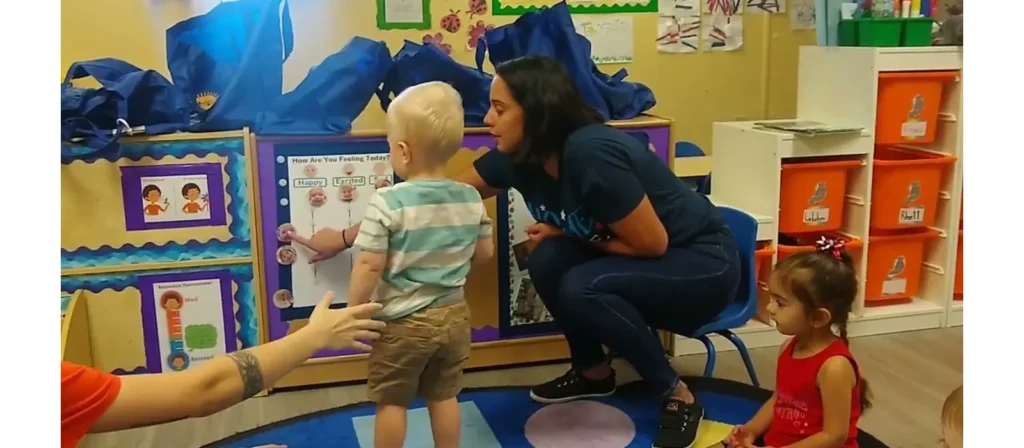
Steps:
- Display a laminated wheel showing faces or icons representing 6–8 common emotions.
- Explain that everyone will have a chance to choose how they feel right now.
- Pass the wheel around or walk it around the circle.
- Ask each child to point to or name the emotion they feel and, optionally, explain why.
- Acknowledge all feelings and reflect on any group trends (e.g., “Many friends are feeling calm today”).
4. Mystery Bag
This interactive guessing game builds vocabulary, descriptive language, and critical thinking skills. A mystery bag contains one familiar classroom object each day. Children use their senses and verbal clues to guess what is inside without seeing it. This activity encourages active listening and peer interaction, while also adding an element of surprise and fun to circle time.
Steps:
- Fill a cloth bag with one classroom item (such as a toy animal, a block, or a paintbrush).
- Hold up the bag and explain that there is one mystery object inside.
- Invite children to ask yes or no questions about the object’s features.
- Offer clues if needed, describing the object’s shape, texture, or use.
- Reveal the item after several guesses and briefly discuss what it is and how it is used.
5. Days of the Week Song
This activity helps children learn the sequence of the days in a fun and musical way. By incorporating rhythm and repetition, children are more likely to retain the names and order of the days. It also helps build early time awareness and gives structure to the daily routine. Singing together builds group unity and keeps children engaged through melody and movement.
Steps:
- Begin by asking the children if they know what day it is today.
- Use a calendar or visual chart to point to today’s day.
- Sing a simple days of the week song with hand gestures or clapping patterns.
- Repeat the song a second time and encourage the children to sing louder or add motions.
- Briefly review yesterday, today, and tomorrow using real-life examples.
6. Guess the Animal
Guess the Animal is a fun and educational circle time activity that promotes vocabulary development, logical reasoning, and listening skills. The teacher or a child gives clues about an animal’s characteristics, such as how it moves, what it eats, or where it lives. The rest of the group uses these clues to guess the animal. This activity encourages turn-taking, critical thinking, and content-related language in a playful setting.
Steps:
- Choose an animal and think of 3 to 5 simple clues about it (e.g., “I live in the ocean,” “I have fins,” “I can swim fast”).
- Read the clues aloud one at a time, pausing to let children guess after each one.
- If the correct animal is not guessed, continue giving additional hints.
- Once a child guesses correctly, briefly discuss the animal—its name, sound, or habitat.
- Invite children to take turns being the clue-giver if developmentally appropriate.
7. Pass the Ball
Pass the Ball is a movement-based game that supports turn-taking, focus, and active participation. It is often used as a quick energizer or as part of a group discussion prompt. When the music plays, the ball is passed around the circle. When the music stops, the child holding the ball can answer a question or perform a simple action.
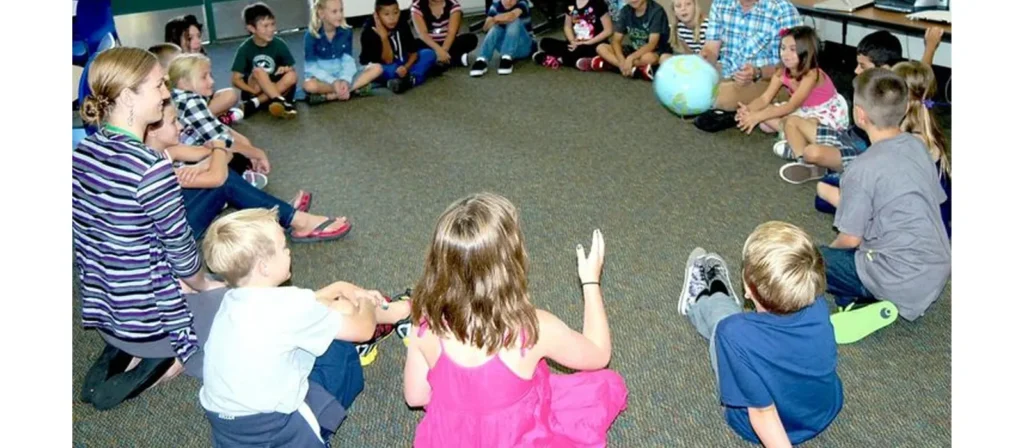
Steps:
- Have children sit in a circle and give one soft ball or bean bag to start.
- Play music as children pass the ball from one to another.
- Pause the music randomly. The child holding the ball shares something (e.g., favorite food, weekend activity).
- Restart the music and continue until several children have had a turn.
- End the game with a group cheer or transition to the next activity.
Pronti a progettare uno spazio che ispiri l'apprendimento? Contattateci per creare soluzioni di arredo personalizzate, su misura per le esigenze della vostra aula.
8. Story Starters
This activity encourages preschoolers to use their imagination and develop storytelling skills. The teacher begins a short sentence like, “One day, a tiny frog jumped into…” and then invites children one at a time to add to the story. This not only enhances vocabulary but also teaches patience, active listening, and the basics of narrative structure.
Steps:
- Begin with a simple and engaging sentence to kick off the story.
- Move around the circle and let each child add a sentence or idea.
- Encourage them to listen carefully and build upon the previous sentence.
- Prompt gently if needed with “What happened next?” or “Then what did the frog see?”
- At the end, recap the full story to reinforce sequencing and memory skills.
9. What’s Missing?
“What’s Missing?” is a memory and observation game where children look at a group of familiar items, close their eyes, and then guess which one was taken away. It encourages visual attention, recall, and early problem-solving. This game is simple to prepare and very effective for strengthening focus and working memory during circle time.
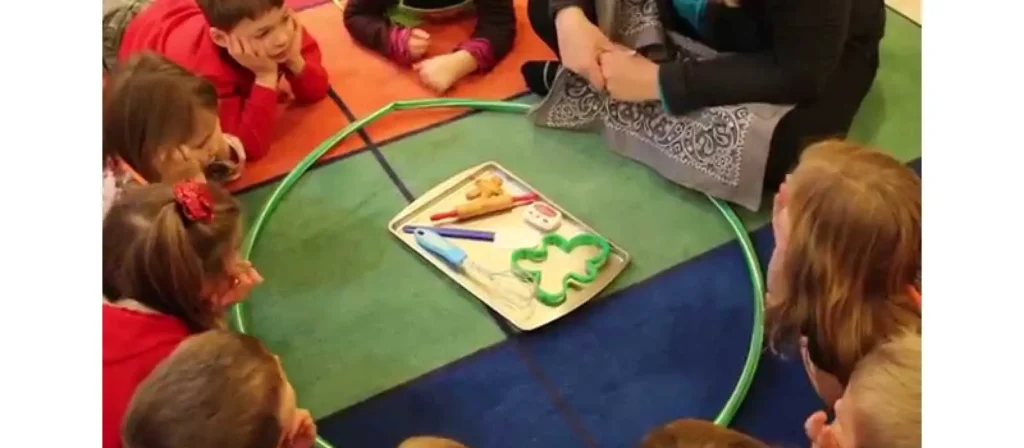
Steps:
- Choose 3–5 small, recognizable items (e.g., a crayon, toy animal, spoon, block).
- Place them on a tray or cloth in the center of the circle.
- Give children 15–20 seconds to study the items.
- Ask them to close their eyes or turn around.
- Quietly remove one object, then invite them to open their eyes.
- Ask, “What’s missing?” and let them guess.
- Repeat with different combinations or increase difficulty by adding more items.
10. Calendar Time
Calendar Time is a daily circle time routine that introduces children to the concepts of day, date, month, and season. It strengthens sequencing skills, supports time awareness, and encourages number recognition. When practiced consistently, it helps children anticipate events and understand the structure of the school day and week. It also builds classroom routine and participation.
Steps:
- Display a large calendar visible to all children.
- Review the day of the week, date, month, and year together.
- Ask questions like “What day was yesterday?” and “What comes next?”
- Use counting to find today’s date and have a child place the number on the calendar.
- Optionally, connect the calendar to class events or birthdays.
11. Show and Tell
Show and Tell is a classic early childhood activity that strengthens communication skills, self-confidence, and peer-to-peer connection. Children bring in an item from home or choose something meaningful from the classroom to share with the group. It encourages speaking in front of others, listening with attention, and asking thoughtful questions. This activity also helps children learn more about one another’s interests and experiences.
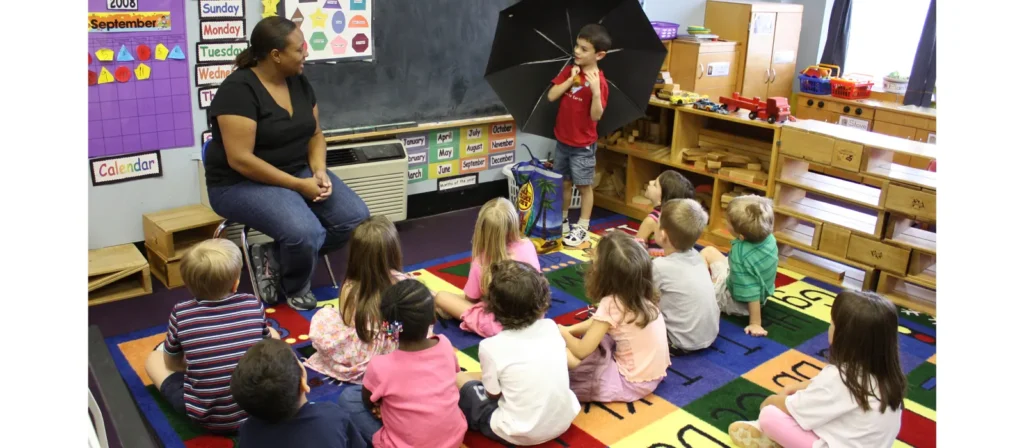
Steps:
- Choose one or two children per day to participate in Show and Tell.
- Have each child take turns showing their item and explaining what it is and why it is special to them.
- Invite the group to ask one or two follow-up questions.
- Thank the speaker and give them a round of applause.
- Remind the group of listening rules and model respectful responses throughout.
12. Guess the Sound
This calming activity invites children to listen carefully and guess a hidden sound. It encourages patience, focused listening, and attention to detail. Teachers can use everyday items or recorded sounds to keep the game fresh and exciting. It’s especially effective during quiet transitions or as a mindfulness moment.
Steps:
- Hide a noisemaker (e.g., keys, a shaker, tapping a pencil) behind a book or screen.
- Make the sound once or twice without showing the object.
- Ask, “What do you think made that sound?” and encourage guesses.
- Reveal the item and briefly discuss what it is and how it sounds.
- Repeat with different objects or invite children to take turns creating sounds.
13. If You’re Happy and You Know It
“If You’re Happy and You Know It” is a widely recognized action song that helps children express emotions through movement. It supports listening comprehension, self-regulation, and gross motor coordination. The predictable pattern and physical engagement make it a highly effective tool for group management and participation during circle time. Children also begin to associate different emotions with actions in a fun, non-verbal way.
Steps:
- Gather children in a seated or standing circle.
- Begin singing: “If you’re happy and you know it, clap your hands.”
- Add movements such as stomping feet, nodding heads, or saying “Hooray!”
- Encourage children to suggest new actions for each verse.
- End with a group cheer or calming verse to transition to the next activity.
14. I Spy
“I Spy” is a simple and engaging observation game that helps children develop vocabulary, visual discrimination, and attention to detail. It encourages children to describe objects by their characteristics, such as color, shape, or size, and supports early critical thinking. This activity is easy to adapt to any classroom setting and can be played with real objects in the room or themed picture cards.
Steps:
- Choose an object within sight of the group, but do not name it.
- Begin by saying, “I spy with my little eye something that is [color/shape/first letter].”
- Encourage children to look around and make guesses one at a time.
- Offer additional clues if needed, such as its location or size.
- When the object is guessed correctly, give praise and invite the guesser to lead the next round.
15. Story Retelling with Props
Story Retelling with Props strengthens children’s comprehension, sequencing, and expressive language. After reading a familiar book, the teacher uses physical props or puppets to help children retell the story. This encourages memory recall, turn-taking, and narrative skills. It also gives children a chance to actively engage with literature in a hands-on, interactive format.
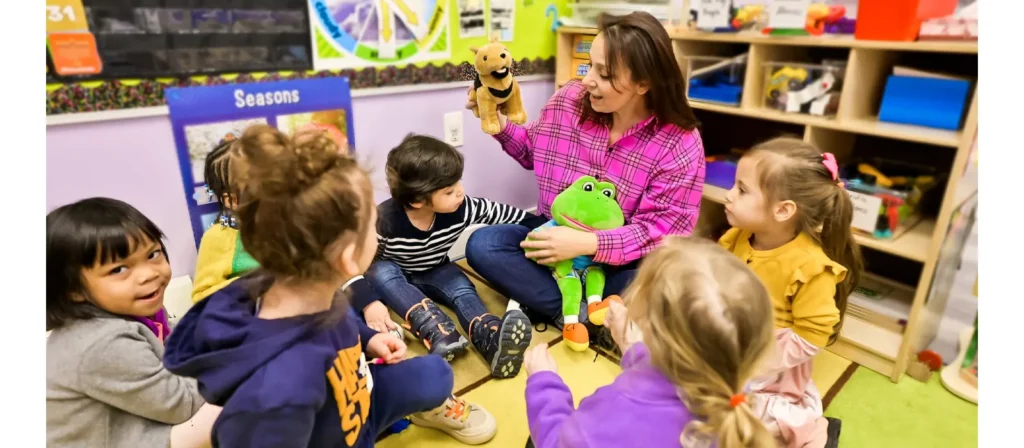
Steps:
- Read a well-known story aloud to the group (e.g., Il bruco molto affamato O Brown Bear, Brown Bear).
- Display props that represent key parts of the story—characters, objects, or settings.
- Ask children to help retell the story using the props in order.
- Guide them through the beginning, middle, and end, encouraging full sentences.
- Let children take turns handling the props or acting out parts if appropriate.
Pronti a progettare uno spazio che ispiri l'apprendimento? Contattateci per creare soluzioni di arredo personalizzate, su misura per le esigenze della vostra aula.
16. Yes or No Game
This quick-thinking game challenges kids to answer silly questions with a simple “yes” or “no.” It can be used as a themed warm-up or a quick review of content areas. It sharpens listening skills and encourages children to think before responding. The playful tone keeps energy high while promoting self-control and understanding of simple concepts.
Steps:
- Ask fun and age-appropriate questions like “Can dogs drive cars?” or “Do fish live in trees?”
- Have children shout “yes!” or “no!” together or raise their hands to respond.
- Pause briefly after each question to let them think before answering.
- Mix in real and silly questions to keep them engaged.
- Optionally, ask “Why do you think so?” to encourage discussion.
17. Movement Freeze Game
Movement Freeze Game is an energetic and highly engaging circle time activity that promotes self-regulation, body control, and listening skills. As music plays, children dance or move freely. When the music stops, they must freeze in place like statues. This helps develop impulse control and focus while giving children a fun and safe way to release energy.
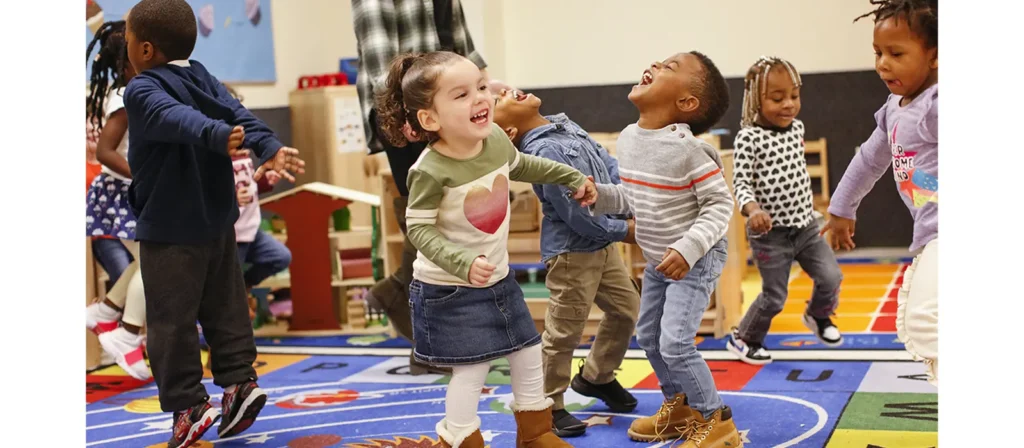
Steps:
- Play fun, upbeat music while children move or dance around in place.
- Randomly pause the music and call out “Freeze!”
- All children must stop and hold their position as still as possible.
- Praise creative poses and stillness before restarting the music.
- Continue for a few rounds, adding variations like “freeze in a silly face” or “freeze like your favorite animal.”
18. Compliment Circle
Compliment Circle builds positive relationships and supports social-emotional learning. Children take turns giving kind words to their classmates, promoting empathy, confidence, and a supportive classroom environment. It helps children practice eye contact, sentence formation, and recognizing the strengths of others.
Steps:
- Explain what a compliment is and give a few child-friendly examples.
- Choose one child to receive compliments from a few peers.
- Model how to give a kind sentence (e.g., “I like how you helped me clean up”).
- Go around the circle, allowing children to give or receive a compliment.
- Continue daily or weekly to make it a regular part of class culture.
19. Pass the Squeeze
Pass the Squeeze is a calm, cooperative circle time activity that promotes connection, awareness, and group unity. Children hold hands in a circle, and a gentle squeeze is passed from one child to the next. This activity encourages physical stillness, turn-taking, and mindful attention to the group. It is especially useful at the beginning of the day or as a transition into quieter routines.
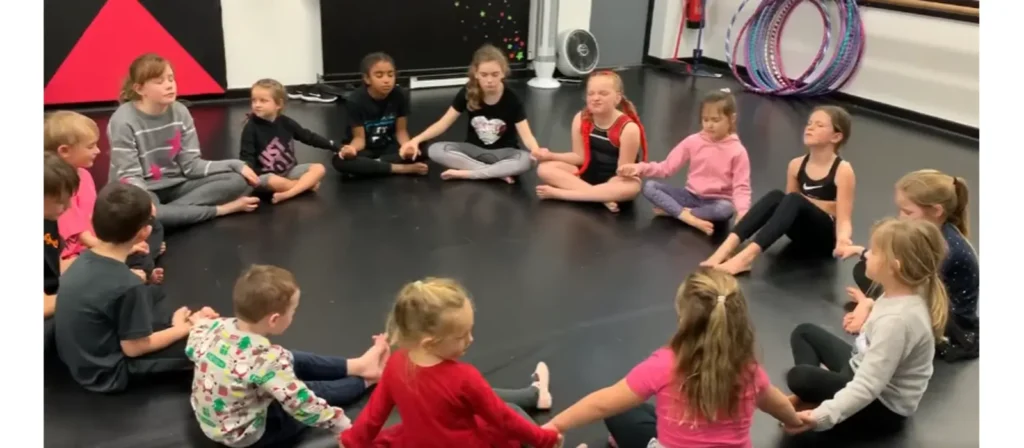
Steps:
- Have children sit or stand in a complete circle, holding hands gently.
- Explain that when they feel a gentle squeeze in one hand, they will quietly pass the squeeze to the next person using their other hand.
- Begin the game by giving a soft squeeze to the child beside you.
- Observe as the squeeze travels silently around the circle.
- After it completes the circle, ask the group how fast it went or how it felt, and repeat if desired.
20. Opposite Action Game
This fun, brain-tickling game helps children learn about opposites through movement. You say a word or perform an action, and the children must respond with the opposite. For example, if you say “stand,” they sit; if you say “quiet,” they make a small sound. This activity encourages listening, cognitive flexibility, and laughter as kids try to keep up with the changing commands.
Steps:
- Begin by explaining what “opposite” means in simple terms.
- Call out a word or perform a basic action (e.g., clap, smile, jump).
- Have the children respond by doing or saying the opposite.
- Start slow and build up to a faster pace for added excitement.
- Mix in silly or unexpected opposites to keep kids engaged.
21. Clap the Pattern
This rhythmic game strengthens children’s memory, concentration, and listening skills while encouraging them to recognize and repeat sound patterns. The teacher starts with a simple clapping pattern, and children listen closely to copy it. As they master each pattern, the challenge can be increased, making it both fun and developmentally enriching.
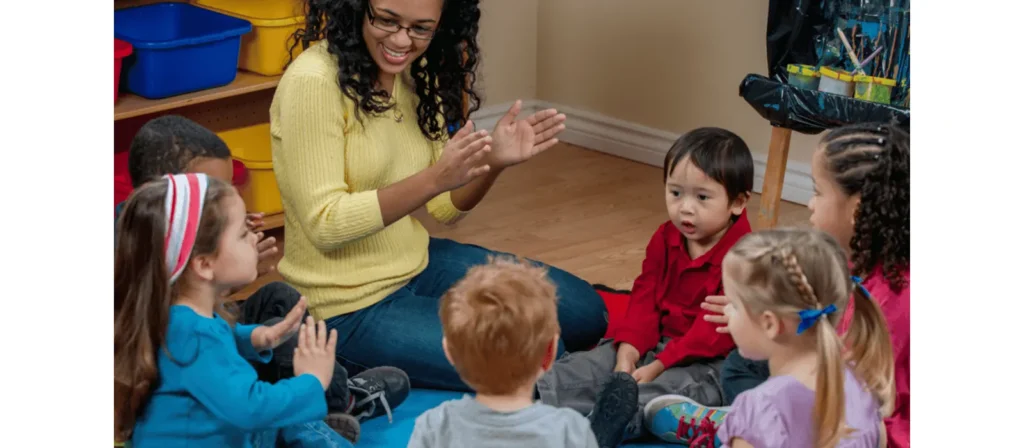
Steps:
- Ask all children to sit in a circle and place their hands on their laps.
- Clap a simple rhythm, such as clap-clap-pause-clap, and ask them to listen.
- Invite the children to repeat the pattern exactly as they heard it.
- Once mastered, try more complex patterns or let children create their own for the group to repeat.
- Offer lots of praise and encourage everyone to try, even if they miss a beat.
22. Sorting by Attribute
Sorting by Attribute is a hands-on cognitive activity that teaches children how to categorize based on observable characteristics like color, shape, or size. It builds early math readiness and helps children verbalize how things are similar or different. The collaborative process also encourages respectful conversation and shared decision-making.
Steps:
- Collect a variety of manipulatives (buttons, toy animals, blocks, etc.) with noticeable differences.
- Spread the items out so that all children can see them.
- Ask, “What’s one way we could sort these?” and model one idea (e.g., by color).
- Invite children to help group the objects accordingly and explain their thinking.
- Repeat using different sorting rules, such as shape or size.
23. Movement Imitation Game
This circle time activity supports physical development and helps children release energy in a structured way. One child or the teacher performs a movement, and the rest of the group copies it. It encourages body awareness, coordination, and focused attention. The activity also gives children the chance to lead, observe, and follow group directions.
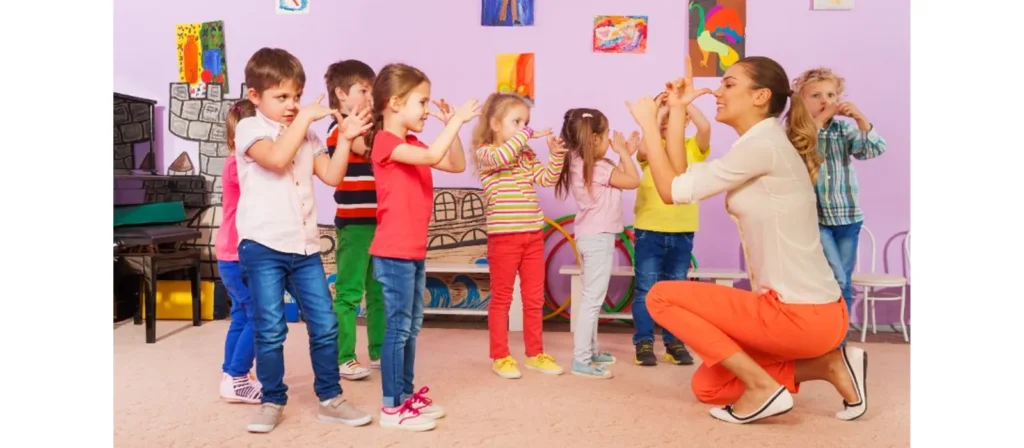
Steps:
- Explain that everyone will take turns copying simple movements.
- Start with a demonstration such as clapping hands, tapping knees, or jumping in place.
- Invite a child to create their own movement for the group to follow.
- Continue around the circle, giving several children a turn to lead.
- Wrap up with a calming motion, such as stretching or deep breathing, to transition to the next activity.
24. Mouse Trap
Mouse Trap is an exciting movement game that teaches quick thinking, turn-taking, and body control. Children form a large circle with their arms held out like a trap, and one child plays the “mouse” who walks around the outside. The goal is for the mouse to gently tap someone and try to run around the circle before being “trapped.” It’s full of giggles and energy while reinforcing listening and coordination.
Steps:
- Have all the children stand in a wide circle holding hands and then raise their arms to form the “trap.”
- Choose one child to be the mouse and walk outside the circle slowly.
- At any moment, the mouse taps someone on the shoulder and begins to run around the circle.
- The tapped child chases the mouse, both trying to reach the open space first.
- Whoever gets back into the circle first rejoins the group, and the other becomes the next mouse.
25. Yoga and Stretching
Yoga is a calm and focused circle time activity that helps preschoolers improve balance, coordination, and body awareness. Gentle poses and simple stretches teach children how to slow down, breathe with intention, and take care of their bodies. This activity also supports self-regulation and mindfulness in a developmentally appropriate way.
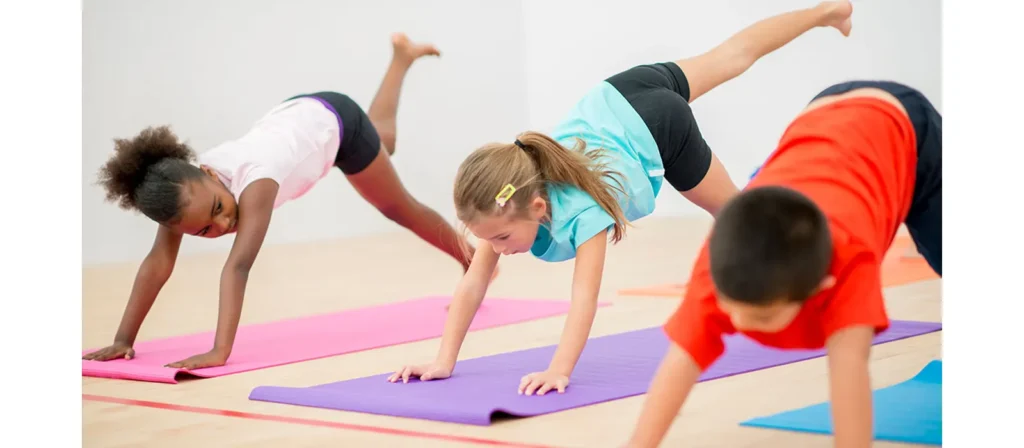
Steps:
- Invite children to find their own space, either sitting or standing, with enough room to move safely.
- Begin with slow shoulder rolls, neck stretches, and deep breaths to help settle the group.
- Introduce a few child-friendly yoga poses, such as butterfly, tree, or downward dog, demonstrating each one clearly.
- Hold each pose for a few seconds, encouraging steady breathing and quiet focus.
- End the session with a few seated stretches and a calming breath together as a group.
Pronti a progettare uno spazio che ispiri l'apprendimento? Contattateci per creare soluzioni di arredo personalizzate, su misura per le esigenze della vostra aula.
26. Emotion Scenarios
Emotion Scenarios helps children build empathy and problem-solving skills by imagining how they would feel or respond in different social situations. The teacher presents short stories or situations, and children discuss how the characters might feel and what they could do. It encourages thoughtful conversation, perspective-taking, and emotional vocabulary.
Steps:
- Prepare simple, relatable scenarios (e.g., “Someone knocked over your block tower. How would you feel?”).
- Read one scenario at a time and pause for group discussion.
- Ask open-ended questions like “What would you do?” or “Has this ever happened to you?”
- Encourage children to listen to each other’s responses and notice differences.
- Summarize helpful strategies and kind choices that come up in the discussion.
27. Through the Hoop
Through the Hoop is a classic cooperative movement activity where children pass a hula hoop around the circle without letting go of each other’s hands. It promotes teamwork, gross motor planning, and problem-solving, while encouraging laughter and coordination. This is an excellent exercise for building group cohesion and teaching children how to work together toward a shared goal. The physical challenge adds excitement and keeps all children actively engaged.
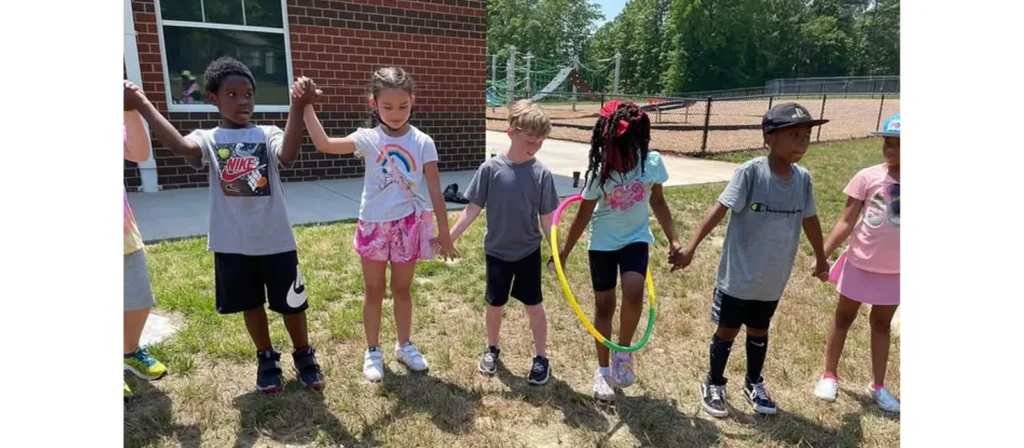
Steps:
- Have children form a large circle and hold hands with the people next to them.
- Place a hula hoop between the arms of two children and close the circle by rejoining their hands inside the hoop.
- Explain that the goal is to move the hoop all the way around the circle without letting go of each other’s hands.
- Encourage children to step, duck, twist, or wiggle through the hoop as it passes along.
- Celebrate when the hoop makes it all the way around, and repeat with variations such as timing the round or trying a different direction.
28. Telephone
This quiet and giggle-worthy game is a great way to teach preschoolers about careful listening, memory, and how messages can change when passed along. Children sit in a circle and whisper a short message from one to another until it reaches the last person. The fun comes in seeing how the message changes by the end, often in hilarious and unexpected ways.
Steps:
- Have all the children sit close together in a circle.
- Whisper a short, simple sentence (like “The cat is wearing a red hat”) to the first child.
- That child then whispers what they heard to the next person, and so on.
- The last child says the sentence out loud to the whole group.
- Reveal the original sentence and enjoy comparing the two versions.
- Repeat with a new message and let a child start the next round.
29. Parachute Games
Parachute games bring energy, teamwork, and lots of smiles into circle time. Using a colorful parachute or large sheet, children work together to lift, lower, and create different movements while following fun prompts. These games strengthen motor skills, listening, cooperation, and social bonding.
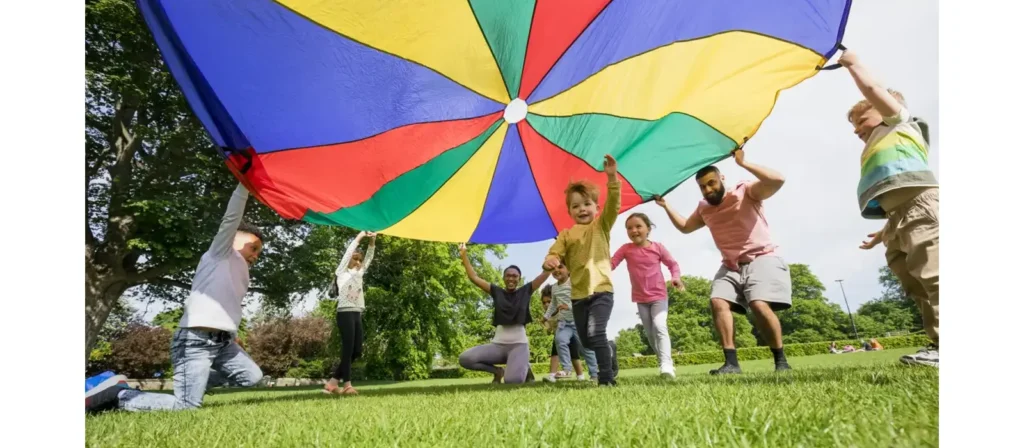
Steps:
- Have children gather around a lightweight parachute, each holding onto the edge with both hands.
- Begin with basic movements like lifting the parachute up together and bringing it down slowly.
- Introduce simple games like “Popcorn” (toss soft balls on the parachute and shake), “Mushroom” (lift high and sit under it as it floats down), or “Color Call” (lift when your shirt color is called).
- Encourage listening, following directions, and moving together as a group.
- Always remind children to hold on with both hands and use gentle, controlled movements.
30. Musical Chairs
Musical Chairs is a lively and engaging circle time activity that builds listening skills, spatial awareness, and emotional regulation. As children move around a circle of chairs while music plays, they must respond quickly when the music stops. This playful challenge helps young children practice stopping and starting their movements on cue and also introduces them to concepts like taking turns and gracefully handling disappointment when a seat is lost.
Steps:
- Set up a circle of chairs, using one fewer chair than the number of children.
- Play a familiar children’s song and invite the group to walk in a circle around the chairs.
- Randomly pause the music and prompt children to find a seat quickly.
- The child left standing may assist the teacher with stopping the music or be gently guided to sit beside an adult as a helper.
- Remove one chair after each round and continue until a final winner is seated, or keep all children involved in non-competitive versions.
Tips for Successful Circle Time
Circle time can be one of the most meaningful parts of a preschooler’s day. Its success depends not just on the activities you choose, but also on how you prepare, present, and respond to the children in your group. These practical tips will help you create a circle time routine that is engaging, effective, and developmentally appropriate.
Choose a Comfortable and Defined Location
A consistent, cozy area helps children recognize that it’s time to come together and focus. Many educators use soft rugs, low round tables, or seating markers to create a clear group space. The goal is to make the area inviting while also supporting structure. When children know where to sit and what to expect in that space, they’re more likely to feel secure and participate willingly.
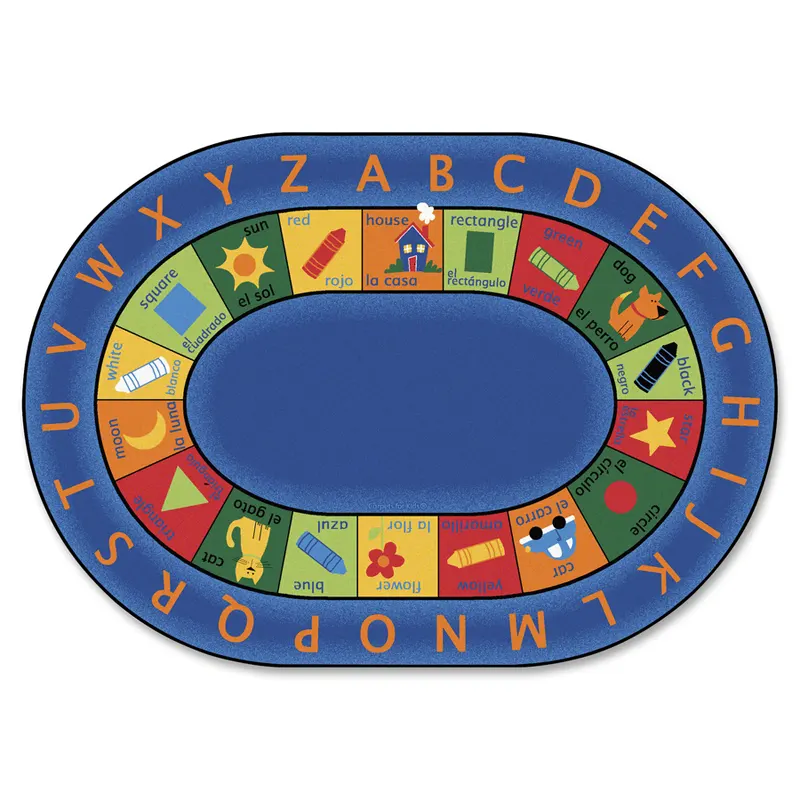
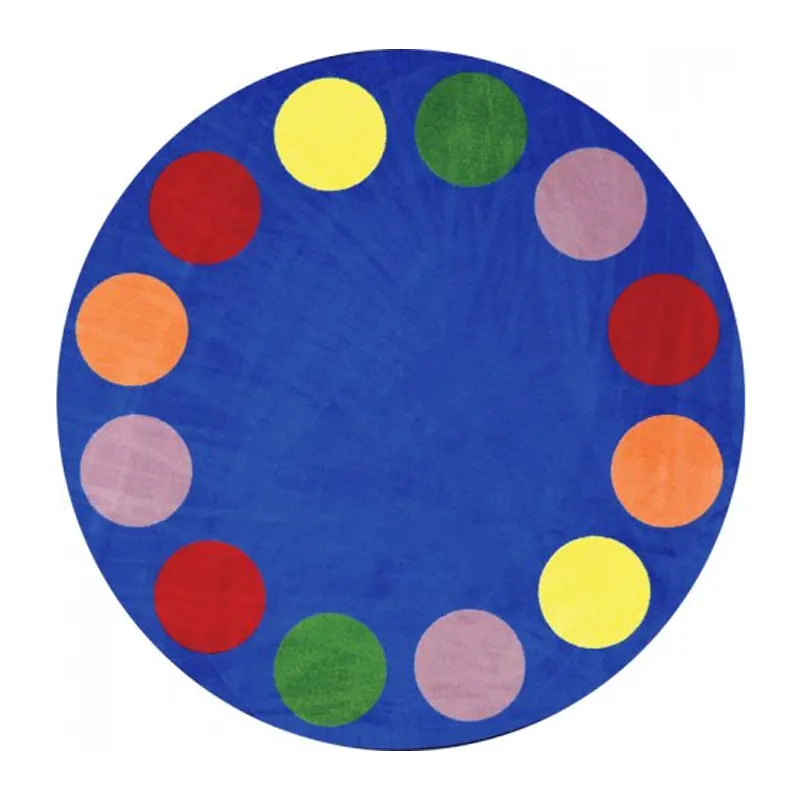
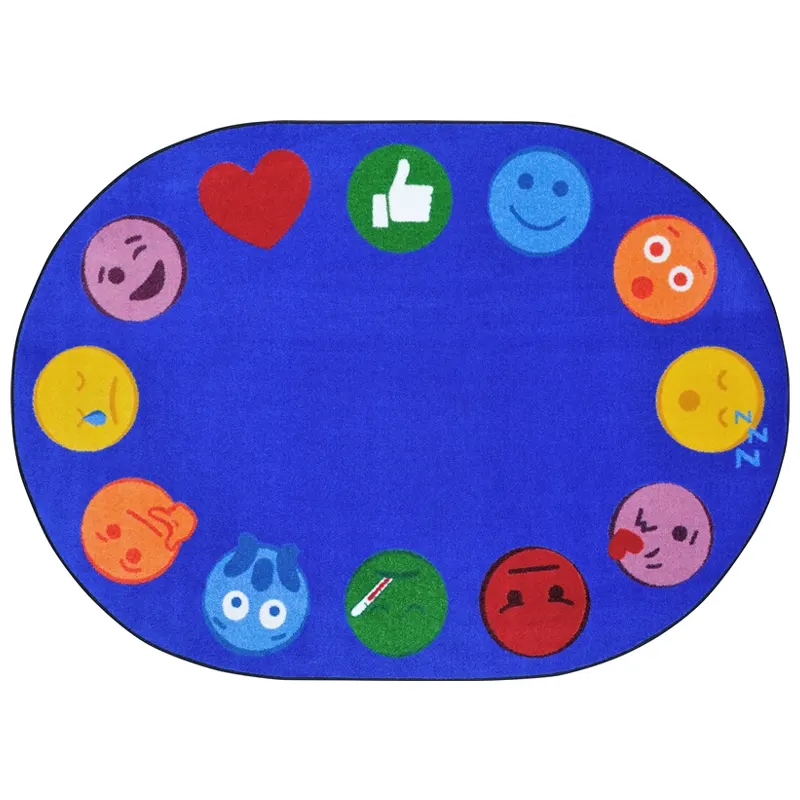
Keep It Short and Purposeful
Young children have short attention spans, so circle time should be brief but focused. Aim for about 10 to 15 minutes, especially with younger preschoolers. It’s best to stop while they are still engaged rather than push through when they begin to lose interest.
Establish Consistent Routines
Predictable routines provide comfort and structure. Starting circle time with the same welcome song or familiar greeting helps children know what to expect. Repetition builds confidence and allows children to participate more independently over time.

Use Visual Aids and Props
Visual supports such as charts, puppets, or flashcards make learning more concrete. Props can help explain ideas, keep attention focused, and support different learning styles. They also make abstract topics like emotions or time more understandable.
Involve Every Child
Create opportunities for every child to participate in some way. This could be through name songs, movement games, or taking turns leading a song. Encourage quieter children gently and allow them to observe before joining in at their own pace.
Stay Flexible and Observant
Even with a solid plan, some days may not go as expected. If the group is restless or tired, adjust the activity to better match their energy and focus. Being responsive to your students’ needs helps maintain a positive learning environment.
Model Enthusiasm and Engagement
Your energy sets the tone. When you show genuine interest and joy during circle time, children are more likely to follow your lead. Use expressive voice, gestures, and eye contact to keep their attention and encourage participation.
Minimize Distractions
Choose a quiet and consistent spot for circle time. Make sure materials are prepared in advance so you do not have to leave the group. Use gentle signals like a soft bell or clapping rhythm to regain attention when needed.
Use Positive Reinforcement
Acknowledge good behavior with specific praise. Instead of saying “good job,” try saying “I noticed how carefully you listened when your friend was talking.” This kind of feedback encourages meaningful behavior and strengthens social-emotional learning.
Offer Variety Within a Predictable Structure
While routines are essential, adding new songs, stories, or themes keeps circle time fresh. You can rotate different activities throughout the week to maintain interest while preserving a familiar flow.
Close with a Clear Transition
End circle time in a consistent way to help children shift smoothly to the next part of the day. A goodbye song, a deep breath, or a special movement cue can serve as a signal that circle time is over and something new is about to begin.
Conclusione
Remember, the most successful circle times come from a combination of structure, flexibility, and genuine connection. By observing your students, adapting to their needs, and leading with enthusiasm, you’ll create a space where every child feels included and excited to participate.
So go ahead, try a new idea, revisit a favorite, and continue building the kind of classroom where children grow, laugh, and thrive together during every circle time.

